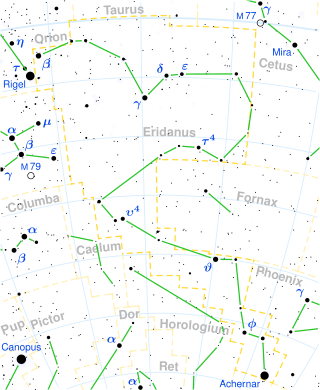HD 24160
| Observation data Epoch J2000 Equinox J2000 | |
|---|---|
| Constellation | Eridanus |
| Right ascension | 03h 49m 27.24527s[1] |
| Declination | −36° 12′ 34.8771″[1] |
| Apparent magnitude (V) | 4.17[2] |
| Characteristics | |
| Spectral type | G7 III[3] |
| B−V color index | 0.927±0.045[2] |
| Astrometry | |
| Radial velocity (Rv) | +2.0±0.7[4] km/s |
| Proper motion (μ) | RA: −45.547(77) mas/yr[1] Dec.: −49.503(108) mas/yr[1] |
| Parallax (π) | 14.9781 ± 0.0915 mas[1] |
| Distance | 218 ± 1 ly (66.8 ± 0.4 pc) |
| Absolute magnitude (MV) | 0.13[2] |
| Details | |
| Mass | 2.33[5] M☉ |
| Radius | 11[6] R☉ |
| Luminosity | 81.3[5] L☉ |
| Surface gravity (log g) | 2.85±0.08[7] cgs |
| Temperature | 4,948±45[5] K |
| Metallicity [Fe/H] | +0.08±0.02[7] dex |
| Age | 1.76[5] Gyr |
| Other designations | |
| Database references | |
| SIMBAD | data |
HD 24160 is a single[9] star in the equatorial constellation of Eridanus. It has the Bayer designation g Eridani. It is visible to the naked eye with an apparent visual magnitude of 4.17.[2] The distance to HD 24160 can be estimated from its annual parallax shift of 14.98 mas,[1] yielding a separation of 218 light years. It is moving further from the Earth with a heliocentric radial velocity of +2 km/s.[4] This object is a coronal member of the Ursa Major Moving Group of stars that share a common motion through space.[10]
At the age of 1.76 billion years old, HD 24160 is an evolved G-type giant star with a stellar classification of G7 III,[3] having consumed the hydrogen at its core and tracked away from the main sequence. It has 2.33[5] times the mass of the Sun and has expanded to about 11[6] times the Sun's radius. The star is radiating 81.3[5] times the Sun's luminosity from its enlarged photosphere at an effective temperature of 4,948 K.[5]
References
[edit]- ^ a b c d e Vallenari, A.; et al. (Gaia collaboration) (2023). "Gaia Data Release 3. Summary of the content and survey properties". Astronomy and Astrophysics. 674: A1. arXiv:2208.00211. Bibcode:2023A&A...674A...1G. doi:10.1051/0004-6361/202243940. S2CID 244398875. Gaia DR3 record for this source at VizieR.
- ^ a b c d Anderson, E.; Francis, Ch. (2012), "XHIP: An extended hipparcos compilation", Astronomy Letters, 38 (5): 331, arXiv:1108.4971, Bibcode:2012AstL...38..331A, doi:10.1134/S1063773712050015, S2CID 119257644.
- ^ a b Keenan, Philip C.; McNeil, Raymond C. (1989), "The Perkins catalog of revised MK types for the cooler stars", Astrophysical Journal Supplement Series, 71: 245, Bibcode:1989ApJS...71..245K, doi:10.1086/191373.
- ^ a b de Bruijne, J. H. J.; Eilers, A.-C. (October 2012), "Radial velocities for the HIPPARCOS-Gaia Hundred-Thousand-Proper-Motion project", Astronomy & Astrophysics, 546: 14, arXiv:1208.3048, Bibcode:2012A&A...546A..61D, doi:10.1051/0004-6361/201219219, S2CID 59451347, A61.
- ^ a b c d e f g Luck, R. Earle (2015), "Abundances in the Local Region. I. G and K Giants", Astronomical Journal, 150 (3), 88, arXiv:1507.01466, Bibcode:2015AJ....150...88L, doi:10.1088/0004-6256/150/3/88, S2CID 118505114.
- ^ a b Pasinetti Fracassini, L. E.; et al. (February 2001), "Catalogue of Apparent Diameters and Absolute Radii of Stars (CADARS) - Third edition - Comments and statistics", Astronomy and Astrophysics, 367 (2): 521–524, arXiv:astro-ph/0012289, Bibcode:2001A&A...367..521P, doi:10.1051/0004-6361:20000451, S2CID 425754.
- ^ a b Alves, S.; et al. (April 2015), "Determination of the spectroscopic stellar parameters for 257 field giant stars", Monthly Notices of the Royal Astronomical Society, 448 (3): 2749–2765, arXiv:1503.02556, Bibcode:2015MNRAS.448.2749A, doi:10.1093/mnras/stv189.
- ^ "HD 24160". SIMBAD. Centre de données astronomiques de Strasbourg. Retrieved 2018-07-23.
- ^ Eggleton, P. P.; Tokovinin, A. A. (2008), "A catalogue of multiplicity among bright stellar systems", Monthly Notices of the Royal Astronomical Society, 389 (2): 869, arXiv:0806.2878, Bibcode:2008MNRAS.389..869E, doi:10.1111/j.1365-2966.2008.13596.x, S2CID 14878976.
- ^ Chupina, N. V.; et al. (June 2006), "Kinematic structure of the corona of the Ursa Major flow found using proper motions and radial velocities of single stars", Astronomy and Astrophysics, 451 (3): 909–916, Bibcode:2006A&A...451..909C, doi:10.1051/0004-6361:20054009.


 French
French Deutsch
Deutsch